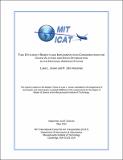Fuel Efficiency Benefits and Implementation Consideration for Cruise Altitude and Speed Optimization in the National Airspace System
Author(s)
Jensen, Luke; Hansman, R. John
DownloadICAT_2014_Jensen.pdf (6.322Mb)
Metadata
Show full item recordAbstract
This study examines the potential fuel burn benefits of altitude and speed optimization in the cruise phase of flight for domestic airlines in the United States. Airlines can achieve cost reductions and reduce environmental impact by making small modifications to the cruise phase operating condition. The efficiency of the National Airspace System can be improved with coordination between air traffic controllers, pilots, and airline dispatchers. This study builds off of prior work in this area to establish best-case benefits assuming full implementation of fuel-optimal cruise altitudes and speeds.
In order to achieve these objectives, a cruise-phase fuel burn estimator was developed using publicly-available radar tracks and weather data. This estimator was used to examine 217,000 flights from 2012. Maximum benefits from altitude optimization (holding speed constant) were found to be on the order 1.96%. The majority of potential altitude benefits can be achieved using step climb optimization, with only marginal gain from cruise climb implementation. The maximum benefits for speed optimization (holding altitude constant) were found to be 1.94% with an average flight time increase of 3.5 minutes per flight. Simultaneous altitude and speed optimization yielded a potential cruise fuel burn reduction of 3.71%. In practice, operational considerations and barriers to implementation limit likely system fuel reduction to lower levels. High-benefit operations within the NAS are identified and potential implementation considerations are discussed.
Date issued
2014-07-29Series/Report no.
ICAT;2014-04
Keywords
fuel burn, air transportation, National Airspace System, environmental impact